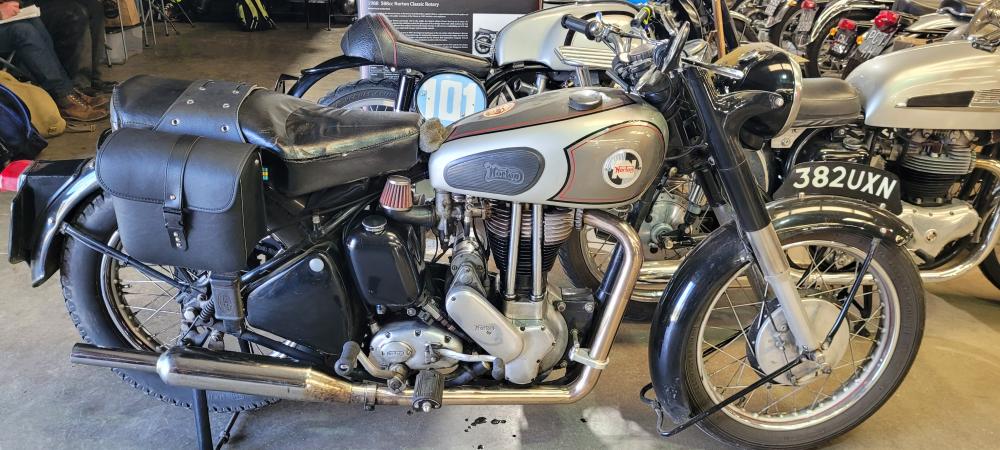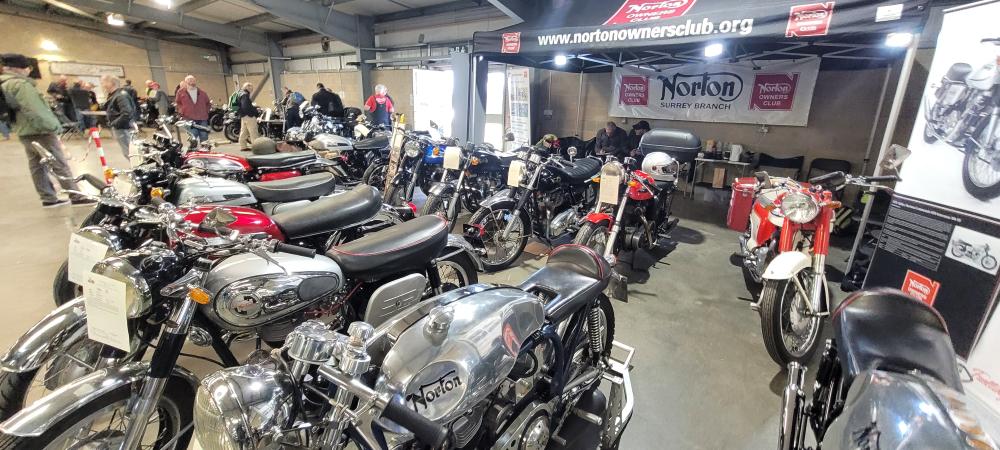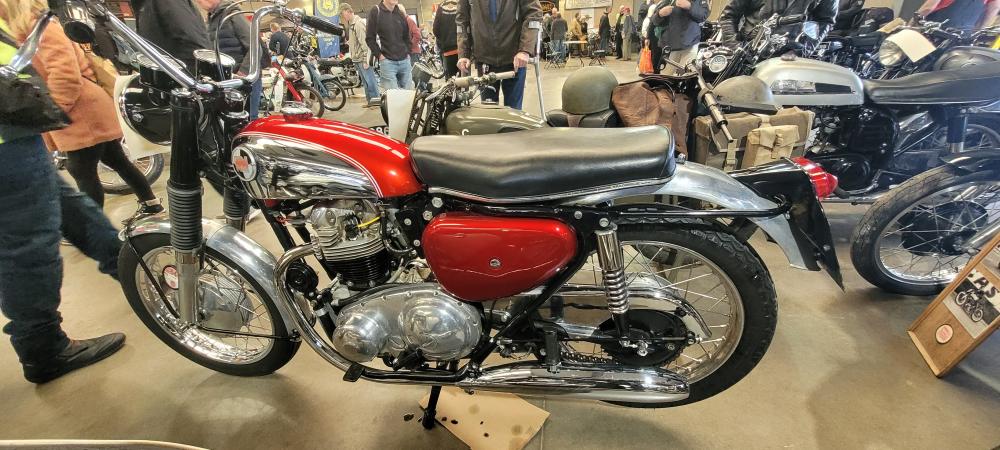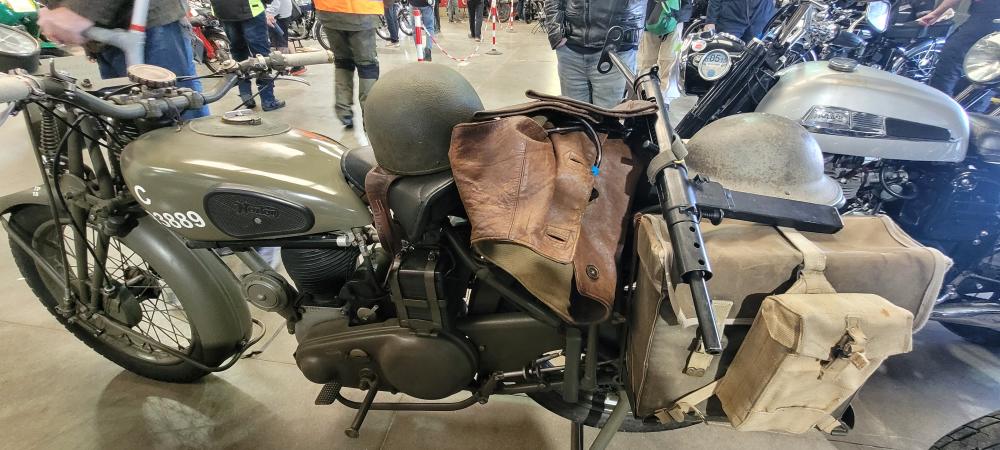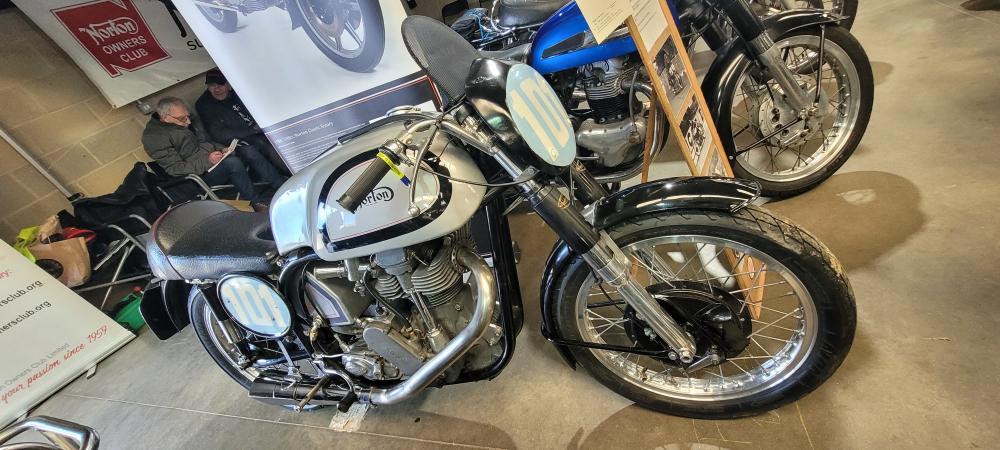1940 to 1958
During the six years of WW2 over 100,000 Nortons were manufactured for military use. These consisted of the two side valve machines, the 16H to 1937 specification with open valve gear and an air cleaner for overseas use; and the Big 4 for sidecar duty, this having a disengageable drive to the sidecar wheel. Production of the rest of the Norton range was suspended until 1946. After the war many ex-WD machines were sold off; one London dealer had 200 for sale at £94 10s 'attractively cellulosed in a pleasing shade of green'. The OHV Model 18 was quickly put back into production in 1946.
The following year the range was further expanded by the plunger framed ES2, otherwise similar to the Model 18. The International models were revived with more road equipment on board than on the pre-war version, though they could be easily stripped for clubmans racing if required. The old CS1 and CJ therefore became redundant and extinct. For the pukka racing fraternity the Manx models were offered for sale, these being SOHC Inters fully equipped for racing purposes, plunger frame, and the telescopic front forks which were now standard on the whole range. The two Mansells left the company; Bill Mansell had been managing director since 1927 and upon his retirement was succeeded by Gilbert Smith. Dennis Mansell had long been a leading trials competitor, winning countless sidecar events on his Norton outfit. Joe Craig returned to Bracebridge Street after a wartime sojourn at AJS. The single cylinder racing Norton was given a new lease of life through the F.I.M., banning both supercharging and the participation of machines from former Axis countries. Engines had to run on low octane fuel so it was to be some time before all the pre-war racing records were eclipsed.
In 1948 the Model 7 was introduced with a 500cc vertical twin engine, plungers, teles, and laid down gearbox. Price was £216 including purchase tax. The designer was Herbert Hopwood and the machine was conceived to directly compete with similar machines from Triumph, BSA and Ariel. The capacity of the Big 4 was reduced to 597cc. Around this time Norton were taking an interest in the American export market and for a number of years entered a works team in the prestigious Daytona 200 race using American riders. These teams, under the care of first Steve Lancefield and then Francis Beart, enjoyed much success until OHC engines were banned in 1952, presumably in order to increase the chances of a certain manufacturer noted for devotion to sidevalves. For 1949 the Manx models were given the DOHC head as previously only fitted to the works bikes. Geoff Duke won the Senior Manx Grand Prix on a Norton, in those days almost a passport to the works team. Norton dominated the racing scene, Harold Daniell was still around and Eric Oliver was the outstanding sidecar exponent. A Norton team of Duke, Oliver, and Artie Bell went to the Montlhéry track near Paris and annexed twenty-one world records in the 350cc and 500cc classes. A special trials machine was introduced, called the 500T; it had the OHV engine with alloy head and solid rear end frame as used on the Model 18, but with more ground clearance.
The Featherbed frame was used on the works racers for the first time in 1950. Designed by the McCandless brothers in Belfast, it made everything else obsolete overnight and became the standard against which all other frames were to be judged for years to come. Material was the lightweight but strong Reynolds 531 and in its original version had the rear sub-frame bolted on. The new frame was an instant success at the 1950 TT, taking Duke to a record breaking Senior win and Bell to victory in the Junior. In both cases a Norton 1-2-3 was recorded. On the roadster singles the laid down gearbox was now fitted. By April 1951 the Featherbed frame was made available on the Manx models sold to the private owners, the works bikes always had the advantage of 'Joe Motors' to keep them in the forefront. At the Earls Court show in November the Dominator Model 88 made its debut to the public. The paintwork was a dark metallic grey and it was fitted with peardrop shaped silencers and a rather ugly but efficient front mudguard. Unfortunately early production was initially for export only, much to the chagrin of the British buying public who had eagerly awaited the new machine and its revolutionary frame.
Norton once again won both Senior and Junior TT races in 1952, Ulsterman Reg Armstrong winning the former, after Duke's retirement, with his rear chain dropping to the ground in the very instant of victory. The portent of the future was the second place going to an MV Agusta, a four cylinder, ridden by Les Graham, a fine and much respected rider who was sadly to lose his life in the following years race. Geoff Duke was world champion in both the 350cc and 500cc classes and was awarded the OBE for his services to motorcycling. The Model 7 and ES2 were both equipped with a new non-Featherbed, pivoting rear fork frame and the peardrop silencers. Very late in the year the Featherbed frame became available on the International models.
In February 1953 Norton Motors were taken over by Associated Motorcycles Limited whose base was at Plumstead, London where they manufactured AJS and Matchless machines among sundry others. Norton continued at Bracebridge Street as before so outwardly there was not a lot of change; but the parent AMC board, whose curious outlook on running a motorcycle industry was to eventually put themselves out of business, were soon at loggerheads with the top brass at Norton so the relationship between the two factories was not always good. Norton had run into financial problems in 1952, partly due to the public eagerly awaiting the Featherbed frame to appear on the home market road models and neglecting to buy the old stuff that was available. Throughout its life, the Featherbed was made by Reynolds Tubes, but at this time they were unable to produce sufficient to enable Norton to sell enough machines to move into profitability. Geoff Duke departed to the Gilera team for 1953; the power of the multi-cylinder designs was now cancelling out Norton's advantage in the roadholding department. This left the Rhodesian Ray Amm as the number one Norton rider. Amm was a particularly hard and fearless rider and these qualities took him to the TT double in that year. He was also the rider of the experimental 'flying fish' kneeler in the North West 200 but was forced to retire after just three laps. On this machine he later raised the one hour record to 133.71mph; the last time it was to be held by a British machine. The Dominator 88 was at last made available on the home market and quickly established itself as a good seller.
The Model 7 was discontinued in 1955. The following year saw the arrival of the Model 99, identical to the 88 except for the engine enlargement to 600cc. This same engine was also combined with the Model 7 cycle parts to produce the Model 77; this lasted only a year or so until parts were cleared from the shelves.
To mark 60 years of the company in 1958, a 250cc OHV twin was produced, called the Jubilee. This featured a Bert Hopwood designed engine combined with various existing AMC cycle parts.
© Norton Owners Club 1987
Originally published in the Norton Owners Club Classic Calendar for 1987

